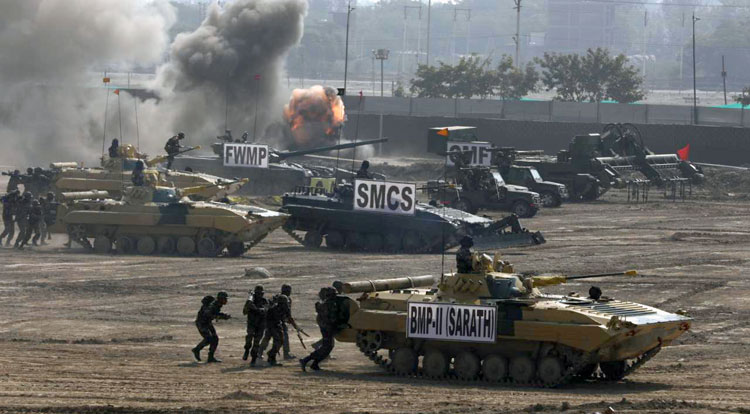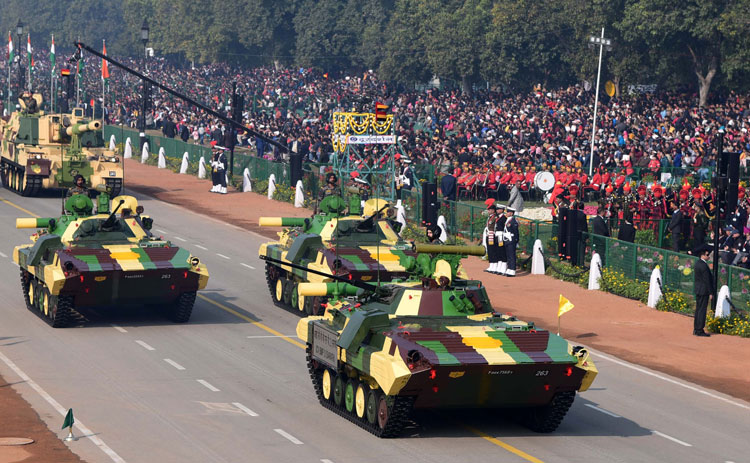INDIAN ARMED FORCES CHIEFS ON OUR RELENTLESS AND FOCUSED PUBLISHING EFFORTS

The insightful articles, inspiring narrations and analytical perspectives presented by the Editorial Team, establish an alluring connect with the reader. My compliments and best wishes to SP Guide Publications.

"Over the past 60 years, the growth of SP Guide Publications has mirrored the rising stature of Indian Navy. Its well-researched and informative magazines on Defence and Aerospace sector have served to shape an educated opinion of our military personnel, policy makers and the public alike. I wish SP's Publication team continued success, fair winds and following seas in all future endeavour!"

Since, its inception in 1964, SP Guide Publications has consistently demonstrated commitment to high-quality journalism in the aerospace and defence sectors, earning a well-deserved reputation as Asia's largest media house in this domain. I wish SP Guide Publications continued success in its pursuit of excellence.
- MoD initiates comprehensive review of Defence Acquisition Procedure 2020, pushes for defence reforms
- G7: The Swansong
- Kalinga Connect: South Asia to Polynesia
- Must Credit DRDO for Operation Sindoor, now what is next for defence R&D?
- The layered Air Defence systems that worked superbly, the key element of Operation Sindoor
- Operation Sindoor | Day 2 DGMOs Briefing
- Operation Sindoor: Resolute yet Restrained
Upgraded Infantry Combat Vehicle ‘Sarath’
 |
The Author is Former Director General of Information Systems and A Special Forces Veteran, Indian Army |

On June 2, 2020, the Ministry of Defence (MoD) placed an order on the Ordnance Factory Board (OFB) for 156 upgraded Russian-origin BMP-2/2k Infantry Combat Vehicles (ICVs) ‘Sarath’ for use by Indian Army’s (IA) mechanised forces at the cost of 1,094 crore ($145 million). Earlier, an OFB spokesperson told media on May 31 that once the order from the MoD is granted, Ordnance Factory Project Medak (OFPM) in Telangana will begin manufacturing the amphibious platforms. Official sources say OFPM, which has assembled and licence-built more than 2,500 units of the BMP-2 and the BMP-2K variant since 1987, will be required to complete delivery of all 156 x ICVs by year 2023.
The Sarath weighing 14.3 tonnes, operated by a 3-man crew is capable of transporting up to seven fully equipped troops. Sarath has an operational range of 600 km and is capable of reaching top speed of 65 km/h on roads, 45 km/h off-road, and 3.8 kt on water. Sarath’s armament includes a 2A42 30mm dual-feed, fully stabilised cannon and a co-axial 7.62mm PKT machine gun. Mounted on the turret roof is a 9Sh119M1 missile launcher for 9M113 Konkurs anti-tank guided missiles (ATGMs). The IA employs some 2,200 x BMP-2/2Ks in assorted roles, including armoured ambulances, amphibious bulldozers, and engineer reconnaissance vehicles. BMP-2 chassis has been used to mount a number of other support equipment like AERV, Dozers, Ambulance, ATGM, Missiles etc. Some ICV variants featuring a modified chassis have been fitted with Nag missile carriers (NAMICAs) capable of deploying up to six locally developed Nag ATGMs. Army showcased the Sarath during the rehearsal for DefExpo 2020 as a mobile autonomous launcher for the BrahMos missile system, Akash weapon system, Smerch launcher and integrated communication electronic warfare system. According to media, induction of these 156 x BMP-2/2k ‘Sarath’ will mitigate the “existing” deficiencies in the mechanised infantry units. But this may not be entirely true. Of the 2,200 Sarath BMPs held by mechanised forces of IA, only 200 have been in service for 10 years or below, age profile of 1200 x Sarath in service is 10 and 20 years, and 100 x Sarath are more than 20 years old. The average design life of most of the major combat/armoured vehicles is 25 to 30 years. Hence, of the 2200 ICVs, around 800 plus are already obsolete or near obsolescence and requires urgent replacement or upgrades. Considering, their shelf life, these needs to be replaced in next 5-10 years.

By year 2020, the total requirement of ICVs will be approximately 2,800 respectively, if all mechanised units are kitted to its full authorisation. A number of production agencies are involved in upgrade of BMP-2 like: Ordnance Factory Trichy for the 30mm 2A42 cannon; MTPF Ambarnath for turret traversing and elevating mechanism plus part missile launcher; Gun Carriage Factory Jabalpur for main gun mount and 81mm smoke grenade launchers; OLF Deharadun for NVDs and gun-sight; BEML KGF for transmission and final drives; BELTEX Madras for 30mm cannon gun stabilizer and electrical cables; BDL Medak for missile and launcher, and; Engine Factory Avadi for production and overhaul of diesel engines. Similarly, some other manufactures of BMP-2 parts are: Ordnance Cable Factory, Chandigarh for periscopes; Ordnance Factory, Kanpur for gunner and commander hatch plates; Gem Precision Tool (P) Ltd Coimbatore and Escorts Limited Faridabad for shock absorbers; Tadiran, Israel for radio sets, and; BEL for major electronic parts including intercom system, Instant fire detection and suppression, and advanced land navigation system.
We are in this state because the Futuristic Infantry Combat Vehicle (FICV) project has been inordinately delayed though mooted by the IA more than a decade back. News reports of January 26, 2020 quoted Army Chief General M.M. Naravane saying that the Army is making efforts to push it’s 10 year-old plan to acquire 2,600 future infantry combat vehicles for the Indian Army at a cost of around 60,000 crore by 2026-27 and that interactions have been held with the stakeholders on progressing the procurement case expeditiously. He said a fresh Request for Information (RFI) has been prepared which will be shared with the industry. Army wants the FICVs to replace its Russian-origin BMP-2 ICVs. Tata Motors, Larsen and Toubro (L&T), Mahindra and Reliance Defence are some of the private firms that had initially shown interest in the development of FICV for the Army. According to Army source, FICV will be fully tracked and capable to operate in any kind of rough terrain. It will have full amphibious capabilities. FICV will be transportable by C-17 and IL-76 aircraft. The Sarath upgrade was bid by private players as well, but was allotted to OFB. The FICV project of 60,000 crores may witness private bidders supported by strategic partners like L&T, Tata Motors, Bharat Forge, Reliance Defence, Mahindra Defence, Tata Power SED, and Punj Lloyd. L&T and Tata Motors had already developed prototypes of the FICV by January 2020. However, with OFB too bidding for the FICV project and MoD’s preference for state-owned enterprises, the FICV contract too may be bagged by OFB.





